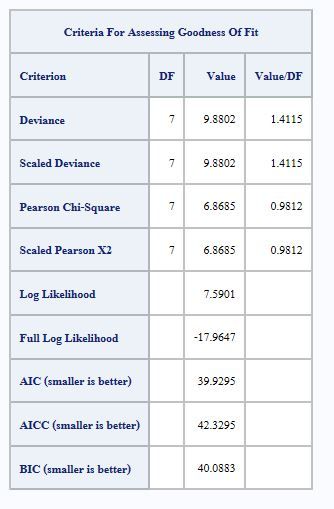- Home
- /
- Programming
- /
- SAS Procedures
- /
- simulation from negative binomail distribution
- RSS Feed
- Mark Topic as New
- Mark Topic as Read
- Float this Topic for Current User
- Bookmark
- Subscribe
- Mute
- Printer Friendly Page
- Mark as New
- Bookmark
- Subscribe
- Mute
- RSS Feed
- Permalink
- Report Inappropriate Content
I am using base sas 9.4. Now I am working on Simulating data.
After I fitted data to negative binomial distribution using the following code ;
proc countreg data=claim;
model y = / dist=negbin;
output out=exp_nb prob=prob_nb;
freq freq;
run;
proc format;
value yfmt
7-high = ">=7";
run;
proc means sum nway data=exp_nb;
class y;
var prob_nb;
format y yfmt.;
output out=exp_nb sum=_testp_;
run;
data exp_nb;
set exp_nb;
sumexp + _testp_;
sumtolast = lag(sumexp);
if y=7 then _testp_ = 1 - sumtolast;
run;
proc freq data=claims;
table y / chisq(testp=exp_nb df=-2 lrchisq);
format y yfmt.;
weight freq;
run;
Then I got only p-value from fitting this data.
Now I want to simulate data from negative binomial distribution.
How can I do that ? please help
(version of sas program do not have Proc iml procedure)
Accepted Solutions
- Mark as New
- Bookmark
- Subscribe
- Mute
- RSS Feed
- Permalink
- Report Inappropriate Content
You can simulate data from a negative binomial distribution using the RAND function like this
data negbin;
do x = 1 to 1000;
y = rand('negbinomial', 0.5, 2);
output;
end;
run;
title 'Plot the Simulated Data';
proc sgplot data = negbin;
histogram y;
run;
title;Adjust p and k to your liking. The documentation is here
http://support.sas.com/documentation/cdl/en/lrdict/64316/HTML/default/viewer.htm#a001466748.htm
- Mark as New
- Bookmark
- Subscribe
- Mute
- RSS Feed
- Permalink
- Report Inappropriate Content
You can simulate data from a negative binomial distribution using the RAND function like this
data negbin;
do x = 1 to 1000;
y = rand('negbinomial', 0.5, 2);
output;
end;
run;
title 'Plot the Simulated Data';
proc sgplot data = negbin;
histogram y;
run;
title;Adjust p and k to your liking. The documentation is here
http://support.sas.com/documentation/cdl/en/lrdict/64316/HTML/default/viewer.htm#a001466748.htm
- Mark as New
- Bookmark
- Subscribe
- Mute
- RSS Feed
- Permalink
- Report Inappropriate Content
could you please tell me that how can I know p of this data from fitting the distribution.
because when I fitted this distribution I fitted from raw data of frequency of claim of each auto policy. That's why I do not know P of this data.
- Mark as New
- Bookmark
- Subscribe
- Mute
- RSS Feed
- Permalink
- Report Inappropriate Content
Ha. Here is.
http://blogs.sas.com/content/iml/2012/04/04/fitting-a-poisson-distribution-to-data-in-sas.html
proc genmod data=MyData;
model N = / dist=negbin;
output out=Fit p=lambda;
run;
- Mark as New
- Bookmark
- Subscribe
- Mute
- RSS Feed
- Permalink
- Report Inappropriate Content
I am sorry to bother you. But after following your suggestion I got the attached output.
How can I know this model fits the data or not.

- Mark as New
- Bookmark
- Subscribe
- Mute
- RSS Feed
- Permalink
- Report Inappropriate Content
It looks good. Value/DF is near 1 .
April 27 – 30 | Gaylord Texan | Grapevine, Texas
Registration is open
Walk in ready to learn. Walk out ready to deliver. This is the data and AI conference you can't afford to miss.
Register now and lock in 2025 pricing—just $495!
Learn the difference between classical and Bayesian statistical approaches and see a few PROC examples to perform Bayesian analysis in this video.
Find more tutorials on the SAS Users YouTube channel.
SAS Training: Just a Click Away
Ready to level-up your skills? Choose your own adventure.



